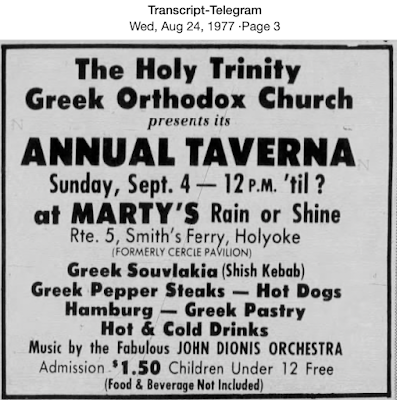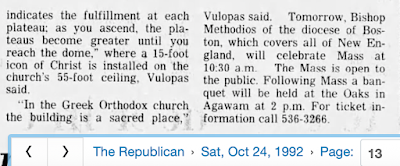One of the joys of writing this blog has been learning about people and places that may have touched my life or that I am interested in learning more about. The Holy Trinity Greek Orthodox Church falls into the latter category and is a fascinating study.
In the early 1900s, Greek immigrants arrived in Holyoke, many seeking opportunities working in the mills. The early arrivals attended the Greek Orthodox Community (Church) in Springfield. By 1906, the first regular Greek Orthodox meetings were held in St. Baptiste Hall on the second floor of the Monument Hall building at the southeast corner of Race and Appleton Street. The first minister arrived in 1914.
The parishioners decided to build a church and acquired a lot from the Skinner estate adjacent to the Skinner Coffee House. The church would be located at 412 Main Street.
Groundbreaking for the new church building was held on January 7, 1916. The ceremony was marked by a parade, headed by a band, that marched from Monument Hall to the church site. 1,000 local Greek residents were present to view the laying of the cornerstone.
The church was designed by Kyriakos Kalfas, a New York architect. Led by the Reverend Sophronios Karapiperas, the church's pastor, the parishioners did most of the excavating work. It is one of the few examples of genuine Byzantine architecture in the Western world and is a replica of the Church of the Pantocrator in Patras, Greece.
The total cost of the lot and building was approximately $50,000, and a mortgage was taken. Holyoke water had contributed $5,500 and Joseph Skinner $1,000 toward the construction.
The church was dedicated to a large audience on November 18, 1917, as the parishioners and guests overflowed onto Main Street.
One-half of the mortgage was paid by active fundraising in March of 1919 to the Holyoke Water Power Company, which financed the endeavor. The church faced adversity with the onset of the Great Depression in 1929, and the loss of many church members who moved to other parts of the country or back to Greece.
Pews were not installed until the mid-1930s, as previously in the Byzantine Rite, parishioners would stand for hours while attending mass.
During the 1930s, the church could not pay down its mortgage, and interest accrued at $850 per year for several years. The $14,000 loan ballooned to $20,500. To explain its predicament, the church met with Holyoke Water Power (HWP). HWP requested that the church raise as much money as it could toward the debt.
By the church's twentieth anniversary, celebrated in 1937, the church raised about $6,500 of the $20,500 remaining mortgage as a sign of goodwill in what was thought to be a hopeless situation in paying back its debt. At the next Board of Directors meeting of Holyoke Water Power, it was agreed that the $6,500 payment would be considered complete satisfaction of the remaining debt. The mortgage was released on November 20, 1938.
Holyoke Water Power was a generous benefactor for many churches, parks, cemeteries, the Holyoke Public Library, societies, organizations, and the City of Holyoke. The total HWP contribution from 1861 to 1944 was $1.6 million, of which the city received about half and churches, societies, and organizations the remainder. The April 10, 1944, Holyoke Transcript Telegram below shows a list of recipients.
In 1950, a soot-clogged chimney caused an oil burner explosion, resulting in smoke damage in the church. There was no fire.
The church purchased adjacent land from HWP to construct a parish house, including an apartment for its pastor, clubrooms, and offices. The deed was recorded on October 26, 1950.
The church celebrated its 35th anniversary with a ball on April 25, 1952, at the Valley Arena Gardens, a short walk from the church.
In July 1960, the church purchased a home at 32 Coit Street to be used as a parish house for its pastor.
Rev. Harry Vulupas became the new church pastor on October 22, 1961. He had been ordained into the priesthood on the preceding Sunday and would serve the church for 51 years.
On January 29, 1977, a major fire devastated half of the church. Carelessly disposed smoking material from the preceding night's pre-nuptial party was determined to be the cause.
The First Lutheran Church and St. Paul's Episcopal Church offered their buildings for use while the fire-damaged church could be restored. St. Paul's was chosen to not infringe on its weekly scheduled services.
Church members voted 2 to 1 to remain at the Main Street location despite the growing problems the area was experiencing.
A gala fundraising Cocktail Party was held at the Yankee Pedlar Opera House on June 19, 1977. Over $10,000 was raised to support the church repairs. The Annual Taverna Greek Festival event was held on September 4, 1977, at Marty's Grove in Smith's Ferry, where a fundraising auction was held.
By May of 1978, parishioners had raised $50,000 through fundraising efforts. This and the fire insurance settlement provided $250,000 for the restoration effort. On May 4, 1980, an open house was held for the public and parishioners to view the restored church building.
In 1996, the two bell towers were reduced in height. The two domes were temporarily removed, and the third level was removed from each tower. The domes were then reinstalled on the second level. The church by this time was 79 years old and had sustained two fires. There was concern that the heavy towers could collapse downward into the church edifice.
In 2012, a celebration was held honoring Rev. Dr. Harry S. Vulopas' 50th anniversary of service at Holy Trinity Greek Orthodox Church. At the time, he had been a pastor for longer than half of the church's existence.
No information was discovered about a 100th anniversary celebration in 2017.
Citations:
Newspapers.com (paid subscription): Citations: Holyoke (Massachusetts) Transcript & Transcript-Telegram; Springfield (Massachusetts) Republican; publication dates and pages are shown.
Holyoke-Chicopee a Perspective, Ella Merkel-Dicarlo, 1982.
The Story of Holyoke, Wyatt E. Harper, 1973.
Massachusetts Historical Commission, MACRIS: Massachusetts Cultural Resource Information System.
Monument Hall Building at Race and Appleton Streets




















































































No comments:
Post a Comment